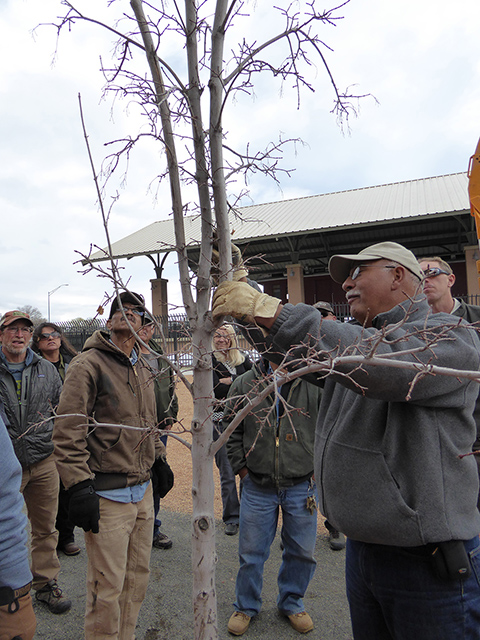

Pruning Workshop Lessons

“If you plant a tree and don’t prune it when needed you’re doing it a disservice,” said Colorado State Forester Vince Urbina at a May tree pruning workshop in Alamosa. “You don’t have to prune it each year, but you should look at each year.” Now is a good time to look closely at your deciduous (sheds leaves annually) trees for structural problems since there are no leaves to get in the way.
The information presented at the workshop was aimed at small to medium-sized pruning jobs that can be carried out using un-powered saws or pruning shears while standing on the ground or on a 10-foot or shorter ladder.
Before bringing out the gear, make sure you know why you’re pruning your tree. Let’s say you live in downtown Alamosa and have a young shade tree that is planted in the strip between the sidewalk and the street. As the tree matures, the goal is to only leave limbs that start eight feet above the ground so people can easily move along the sidewalk – this is part of Alamosa’s tree ordinance. And trees over streets need a 14-foot clearance.
The limbs below the eight-foot height are temporary branches according to Urbina. On the one hand, you don’t want them to get too large before trimming them; on the other hand you don’t want to trim them too soon as they provide fuel for the tree and help increase caliper size (the diameter of the trunk).
During the afternoon field trip, the group walked around the Alamosa City Complex to look at trees, most of which were planted four years ago. The first thing Urbina looks for is the last season’s tree growth. He looks for the terminal bud scar. “Scars are left behind when the scales from last year’s terminal bud dropped off as new leaves expanded in the spring and the twig grew throughout the reason,” states the Norton-Brown Herbarium’s (University of Maryland College Park) website. The new growth is from the scar to the tip of the stem.
New growth of only an inch or two indicates the tree hasn’t recovered from transplanting. In that case, Vince will only prune dead or broken branches. It generally takes a tree one year to recover for each inch of tree caliper measured six inches from the ground. One ash tree that was doing very well had stems that grew 18 inches last year. On the other hand, the three Shademaster Honey Locusts that were planted last May had only a couple of inches of new growth.
If there is sufficient new growth, Urbina next steps back and looks at the overall shape of the tree. For most shade trees, you want a dominant leader that is a fairly straight branch that is taller than the other branches. Over the years, he says he learned not to fight trees and he estimates he’s pruned about one-half million trees. If two or more branches are about the same height, you need to prune so that only one is dominant. Look closely, the best branch may not be the original leader. We looked at several trees that had a larger diameter branch that came off the main trunk just below the original leader. According to Urbina, “That is the branch the tree wants as the leader.”
Next, look at the tree trunk. Is there one main trunk? Or does the tree split into two or more trunks fairly nearer the ground? Having codominant trunks will lead to problems as the tree matures – there won’t be enough room for each branch to expand. Of course the best way to avoid this situation is at the nursery; don’t by a shade tree that doesn’t have a single trunk! Many years ago when I bought a cottonwood, I didn’t know this. Since you don’t want to trim more than 25% - 30% of a shade tree in a year, it took us two years to prune the tree. The first year we took off the top half of the smaller branch, and removed the rest the next year. The tree is doing well now.
Check for branches that cross over other branches and will rub against each other as the tree grows. In deciding which branches to remove, look at the direction of all the branches. Urbina likes to make sure there are good branches growing in each of four directions out from the trunk.
For instructions on how to actually prune a branch, the Colorado Tree Coalition has new plastic cards that are a dollar each at the Alamosa Forest Service office at 129 Santa Fe Ave.: 587-0915. Or check out the Publications for Homeowners & Landowners at the csf.colostate.edu website.
“Stand still. The trees ahead and bush beside you are not lost.” Albert Einstein